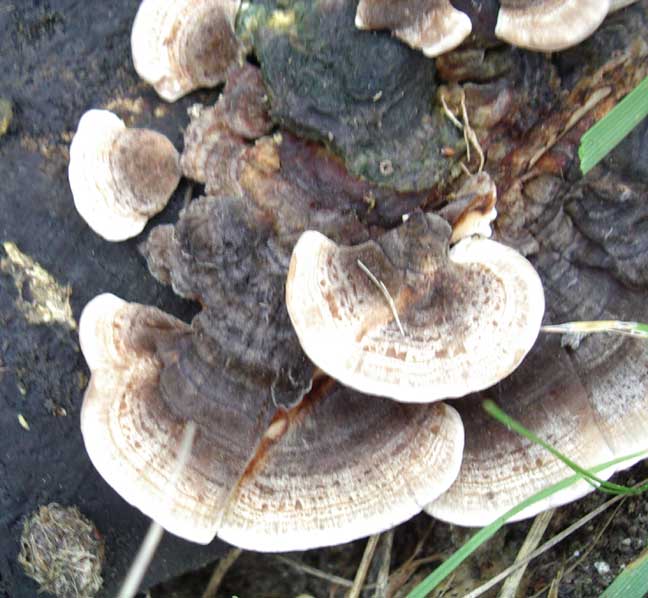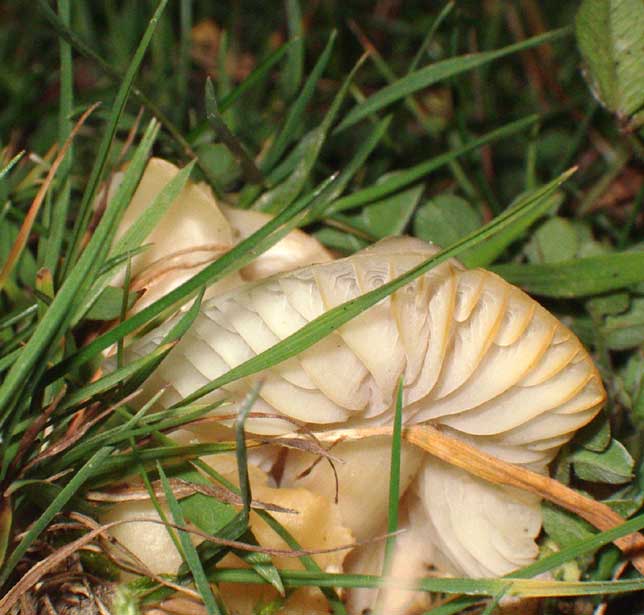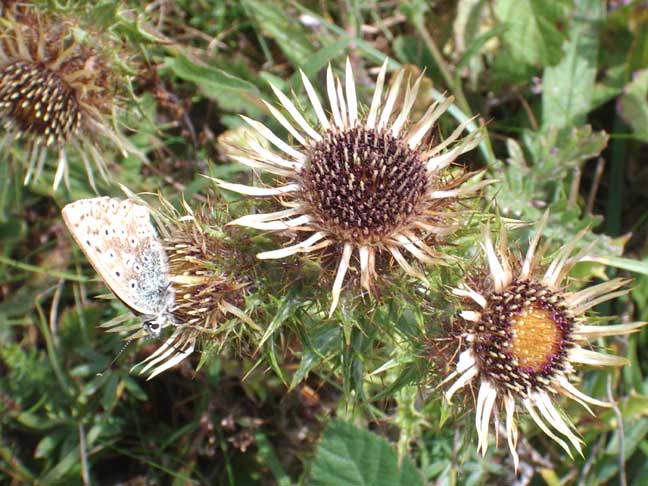 The
Triangle (Mill Hill)
The
Triangle (Mill Hill) The
Triangle (Mill Hill)
The
Triangle (Mill Hill) 30
November 2004
30
November 2004
On
the middle slopes (Triangle area) two further small mushrooms were seen.
The first solitary one (on right) has not been identified. The second species,
with at least two discovered, was the Pale
Wax Cap, Hygrocybe pratensis var pallida.
There
was a group of the common bracket fungus Trametes
versicolor on a stump.
22
November 2004
Some
of the Dogwood
was beginning to flower in the area on Mill
Hill I have christened the Triangle.
 16
November 2004
16
November 2004
Observations
indicated the creamy-white and brownish-cream
mushrooms photographed below
were one and the same species, tentatively identified (wrongly)
as the the Snowy Wax Cap,
Hygrocybe
virginea var.
virginea (=
Cuphophyllus
niveus) (or it could be the Pale
Wax Cap, Hygrocybe pratensis var
pallida) .
This species has now been confirmed as the Pale Wax Cap, Hygrocybe berkeleyi, (known on the British Mycological List as Hygrocybe pratensis var pallida).
Cercle de Mycologie de mons (Belgique) page perso de JJ.WuilbautThere
was one other small brown mushroom and
some bracket fungi on a tree stump and
the only plant in flower in any quantity were the last of the Ribbed
Melilot. (This could be the Tall
Melilot.)
 |
 |
Trametes versicolor. |
11
November 2004
A
small white
mushroom was discovered near the seat,
in the longer grass right next to the path which had been trampled to short
grass.
  |
 |
This is the same species and same colour as the other white mushroom (larger at 50 mm cap diameter) and flash photograph has produced a slight colour hue. |
Mushroom
Report on Mill Hill (with images)
Adur
Wax Caps
8 October
2004
Only
one butterfly was seen on the upper slopes
of Mill Hill, and this was a Comma
in a glade south of the upper car park.
 Hairy
Violets (originally thought to be Sweet Violets) were
in flower near the path at the furthest part down the slope (west) where
it carves through the Horseshoe Vetch and Bird's Foot Trefoil. These were
plants of the short turf, scarcely rising to 40 mm (estimated) in height.
These violets
are I actually emerging through patches of Horseshoe
Vetch.
Hairy
Violets (originally thought to be Sweet Violets) were
in flower near the path at the furthest part down the slope (west) where
it carves through the Horseshoe Vetch and Bird's Foot Trefoil. These were
plants of the short turf, scarcely rising to 40 mm (estimated) in height.
These violets
are I actually emerging through patches of Horseshoe
Vetch.
2 September
2004
A
pristine Adonis Blue Butterfly
was noted flying in the vicinity of the Horseshoe Vetch.
22
August 2004
The
bare
patch that gave this web page its original title in March
2003 from a conservation work fire the previous
autumn has now completely merged into the ground flora of ruderal thistles
and early coloning plants and is now indistinguishable from the other ground
flora. A good condition
Painted Lady Butterfly
was seen on the chalk path on the northern edge of this area.
20
August 2004
 In
the warm (21.3 ºC)
fresh breeze (Force 5) it was too windy for
many butterflies and at the end of the Chalkhill
Blue flight period with just 40 butterflies
(28 male and 12 female), with almost half of them in the Triangle are of
the upper slopes. Ten Chalkhill Blues
(six females) clustered around a single Carline
Thistle plant. Common
Blues (a dozen) and more than one Brown
Argus Butterfly were in the longer grass
to the north of then Triangle area near the footpath that borders the reserve
on the northern edge.
In
the warm (21.3 ºC)
fresh breeze (Force 5) it was too windy for
many butterflies and at the end of the Chalkhill
Blue flight period with just 40 butterflies
(28 male and 12 female), with almost half of them in the Triangle are of
the upper slopes. Ten Chalkhill Blues
(six females) clustered around a single Carline
Thistle plant. Common
Blues (a dozen) and more than one Brown
Argus Butterfly were in the longer grass
to the north of then Triangle area near the footpath that borders the reserve
on the northern edge.
16
August 2004
On
a westerly breezy and overcast day, this area hosted a handful of Common
Blue Butterflies, two Chalkhill
Blues, one Painted
Lady and and a solitary Adonis
Blue looking
very bright and large flying rapidly.
27
July 2004
Just
two Chalkhill
Blue Butterflies and
four Common Blue Butterflies in
this middle area, but there was a Wall
Brown Butterfly on a Bramble
bush on the path in the north-east corner. There was a Small
Heath Butterfly on the same Bramble with
both Gatekeepers
and Meadow Brown Butterflies
as well. More than half dozen Six-spot
Burnet Moths were seen instantly.
 |
 |
 |
24
July 2004
A
handful of Common Blue Butterflies
were present, with just one Chalkhill Blue
in this area of medium-long grasses and Scabious
with other wild flowers. .
15
July 2004
Stemless
Thistle were particularly noticeable in
this area, with Field? Scabious. The
leaves on the Scabious
plants differ from being almost negligible on the dimunitive plants on
the lower slopes of Mill
Hill to extensive leaf growths on the steps in the north-west
corner (near the stile) of the Mill Hill Nature
Reserve and in the Lancing College fields on the north side of the
bridleway between Hoe Cottages and the Sussex Pad. In the Triangle the
leaves are large but not nearly as bulky as they can be. The other similar
species is the Small Scabious.
 |
 |
13
June 2004
In
contrast to previous years the Bird's Foot
Trefoil was more extensive on the middle
slopes, right next to and even dominating the Horseshoe
Vetch which was no longer in flower.
Horseshoe
Vetch in 2003
10
May 2004
This
central area had perked up a bit in the last week with Field
Mouse-ear* in small
clumps and more than last year, blue carpets of Germander
Speedwell, yellow flowering of Horseshoe
Vetch (this year, chronologically compatible
with that on the lower slopes) and small clumps
of Cowslips
and Agaric mushrooms
in the short grass and which seem to be associated with cleared patches.
These were the same fungi that could be found
south of the reservoir on the upper slopes.
Fungi
of the Downs in May 2004
 |
 |
 |
|
Cerastium arvense |
|
|
* Field Mouse-ear was a belated suggestion (by Richard Collingridge on UK Botany) and one that I missed with the original identification. This seems more much likely.
 In
the patch that started this page, there were still ruderal annual plants
but the patch had almost disappeared and merged into the general vegetation.
In
the patch that started this page, there were still ruderal annual plants
but the patch had almost disappeared and merged into the general vegetation.
15
April 2004
This
dried out mushroom stood out from the still short grasses.
1 March
2004
There
was a bumblebee mimic hoverfly
amongst the violets. It appeared to be mimicking a bumblebee with an orange
tail. Its hovering
gave it away from a true bumblebee.
Hoverflies
of Adur
 26
March 2004
26
March 2004
Sweet
Violets in purple are scattered with hundreds
of plants over the sheltered bits of Mill Hill,
mostly violet
in colour but in the Triangle area of the middle slopes all white flowers
were present. This is a very common wild flower.
The identification is being made principally because of the white flower,
although the flowering time was considered. The spur confirms that these
are Sweet Violets (not the Dog Violets
of the lower slopes.)
Violets
of Mill Hill
15
December 2003
Small
areas of the scrub on the middle slopes in the north-east corner have been
cleared of vegetation including the instrusive Dogwood
in the area I have christened as the Triangle. The amount of clearance
could be compared to previous years, creating glades that have previously
been favoured by Common Blue Butterflies.